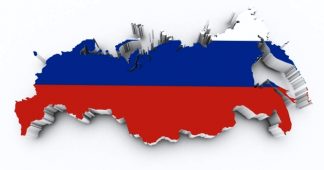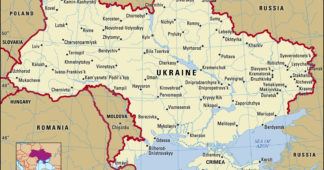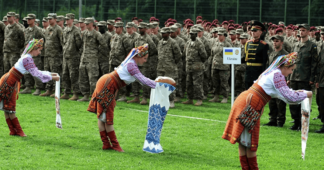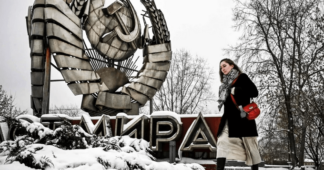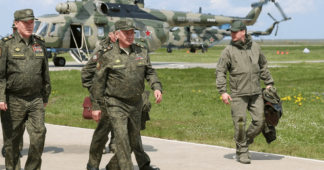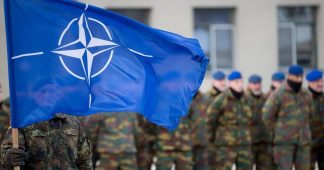Posted on
On January 10, American and Russian officials will meet to discuss Putin’s proposal on mutual security guarantees. Western media and political analysts have cast Putin’s demands that NATO not expand further east to Ukraine and that NATO not establish military bases in former Soviet states nor use them to carry out military activity as bold and impossible.
Here are six crucial pieces of background that the western media will not tell you.
The NATO Promise
Putin’s demands are only bold if it is bold to ask NATO to keep its promises; his demands are only impossible if it is impossible for NATO to keep its promises.
On February 9, 1990, Secretary of State James Baker assured Gorbachev that if NATO got Germany – a huge concession – NATO would not expand one inch east of Germany. The next day, West German Foreign Minister Hans-Dietrich Genscher made the same promise to his Soviet counterpart, Eduard Shevardnadz. Earlier, on January 31, 1990, Genscher had already publicly declared in a major speech that there would not be “an expansion of NATO territory to the east, in other words, closer to the borders of the Soviet Union.”
Recently declassified documents make it clear that all the western powers, including not only the US and Germany but also the UK and France, repeatedly made Russia the same promise.
Seven years later, when the US had already broken that promise, Clinton made Russia a second promise. Having expanded NATO far east of Germany, at least they would not permanently station substantial combat forces. That was the promise the US signed in the NATO-Russia Founding Act on Mutual Relations. It was a reiteration of the earlier February 1990 promise that, not only NATO membership, but NATO troops would not extend east.
So, far from being bold or asking the ridiculous, what the media will not tell you is that Putin is not asking for any new Western concessions. He is asking only that the West honor the commitments it has already made.
The Coup
The catalyst for the crisis today in Ukraine was the 2014 coup. That coup was set up and supported by the US. Ukrainian President Viktor Yanukovych was faced with the choice of economic alliance with the European Union or with Russia. Polls at the time clearly showed that Ukrainians were nearly evenly split on which economic alliance to choose. Yanukovych’s choice of either package would have divided the country. Putin offered Yanukovych a way out: both Russia and the EU could help Ukraine and Yanukovych doesn’t have to be forced to choose. The US and EU rejected Putin’s peace offering. According to Stephen Cohen, Professor Emeritus of Russian Studies at Princeton, “it was the European Union, backed by Washington, that said in November to the democratically elected President of a profoundly divided country, Ukraine, ‘You must choose between Europe and Russia.’”
The stage was now set for strife in Ukraine. And the US stoked that strife. Led by Senator John McCain and Assistant Secretary of State for European and Eurasian affairs Victoria Nuland, the US publicly endorsed and supported the coup protesters. The White House then provided cover and legitimacy to the violent protesters in the streets. Through The National Endowment for Democracy, the US also funded projects that helped fuel the coup.
More sinister than that even, the US was deeply involved in the plotting of the coup itself. Nuland was caught plotting who the Americans want to be the winner of the regime change. She can be heard on an intercepted call telling the American ambassador in Kiev, Geoffrey Pyatt, that Arseniy Yatsenyuk is America’s choice to replace Yanukovych (and he did). Most importantly, Pyatt refers to the West needing to “midwife this thing,” a metaphorical admission of America’s role in leading the coup. At one point, Nuland even seems to say that then Vice President Biden, himself, would be willing to do the midwifery.
Nuland then pressured security forces to stop guarding government buildings and allow the coup protesters in. The opposition then took advantage of the absence of MPs from the south and east because of a pre-scheduled congress of regional politicians and of intimidation that forced many others to flee to ensure that it had the numbers to take over parliament in a coup disguised as democracy.
So instead of a Russian puppet president betraying his people and abandoning an economic alliance with the European Union in favor of an economic alliance with Russia, what the media will not tell you is that the catalyst of the current crisis was a US engineered and supported coup of a democratically elected president.
The Connection
The media will also not tell you about the crucial connection between the NATO promise not to expand east and the coup in Ukraine. The economic alliance with the EU was not the benign package presented to the Western pubic. It was not just an economic offer. According to Professor Emeritus of Russian Studies at Princeton, Stephen Cohen, the European Union proposal also “included ‘security policy’ provisions . . . that would apparently subordinate Ukraine to NATO.” The provisions compelled Ukraine to “adhere to Europe’s ‘military and security’ policies.” So the proposal was not a benign economic agreement: it was a security threat to Russia in economic sheep’s clothing.
Professor of Russian and European Politics at the University of Kent Richard Sakwa says, “EU enlargement paves the way to NATO membership” and points out that, since 1989, every new member of the EU has become a member of NATO. It’s not only that the EU package subordinated Ukraine to NATO, since the EU Treaty of Lisbon went into effect in 2009, all new members of the EU are required to align their defense and security policies with NATO.
Far from being just an economic agreement, Article 4 of the EU’s Association Agreement with Ukraine says the Agreement will “promote gradual convergence on foreign and security matters with the aim of Ukraine’s ever-deeper involvement in the European security area.” Article 7 speaks of the convergence of security and defense, and Article 10 says that “the parties shall explore the potential of military and technological cooperation.”
So, the EU economic alliance was an aggressive package that hid in it NATO’s expansion right up to Russia’s border. The media won’t tell you that either.
What Crimea Wants
What made Russia’s annexation of Crimea so threatening to the US was not the annexation itself. In itself, Crimea is not so important to the US. What was so threatening was what the annexation meant in terms of Russia’s relationship to the US and in terms of its changing role in the world order.
Alexander Lukin, who is Head of Department of International Relations at National Research University Higher School of Economics in Moscow and an authority on Russian politics and international relations, explains that the reason the annexation of Crimea was crucial is that, prior to that, since the end of the Cold War, Russia had been considered a subordinate partner of the West. In all disagreements between Russia and the US up to then, Russia had compromised, and the disagreements were resolved rather quickly. “The crisis in Ukraine and Russia’s reaction to it have fundamentally changed this consensus,” Lukin says. “Russia refused to play by the rules.” Crimea marked the end of the unipolar world of American hegemony. Russia drew the line and asserted itself as a new pole in a multipolar world order. That is why the US is so threatened by Russia’s response to the events of 2014 and the US coup. It is the battle over which US hegemony will be fought.
The coup in Ukraine led to the Russian annexation of Crimea. But that was not an act of aggression. It was a defensive reaction to Western encroachment deep into its sphere of influence and right up to its borders. It was a defensive reaction to the oppression of Russian-speaking people on its borders. NATO expansion had knocked on Russia’s doors. In 2014, “it came to ‘brotherly’ Ukraine,” as Lukin puts it, “a region for which Russia has special feelings and most of whose residents consider themselves Russian.” That was Russia’s red line, and it annexed Crimea. But not as an act of aggression. Rather the annexation was “in response to the aspirations of a majority of its residents.”
Sakwa says that “It is clear that the majority of the Crimean population favored unification with Russia.” A majority voted for unification with Russia when the question was put to a referendum. The accuracy of the exact result has been the subject of debate, but Sakwa says that “even in perfect conditions a majority in Crimea would have voted for union with Russia.”
So, far from being an act of Russian aggression in seizing Crimea, what the media will not tell you is that Russia was responding to Western aggression and answering the call of the majority of the people of Crimea.
What the Donbas and Russia Want
While the US and the Western media exaggerate the threat of an unprovoked Russian invasion of Ukraine – an invasion Noam Chomsky has recently said that “most serious analysts doubt” – what they won’t tell you is that Russia wants very badly not to invade Ukraine. That’s why they haven’t for the past seven years. Anatol Lieven, who is a senior research fellow at the Quincy Institute for Responsible Statecraft, points out that “Russia has not annexed Donetsk and Luhansk (the two Ukrainian provinces that make up the Donbas) or recognized their independence.” He says that “annexation is not Russia’s preferred option for the future of the [Donbas] region,” and adds the important reminder that “Moscow could have annexed the Donbas (as it did Crimea) at any time during the past seven years but has refrained from doing so.”
When the Donbas region of Eastern Ukraine tried to follow Crimea’s path back to Russia, Putin tried to prevent their referendums, even while he accepted Crimea’s. Sakwa reports in Frontline Ukraine that “Putin showed little sign of wanting a Crimea-style takeover of the region, repeatedly rejecting requests to accept the territory as part of Russia.” When Donbas did hold elections, though Putin “respected” the results, he declined to accept them or be bound by them.
In addition to Russia’s actions being defensive and not expansionist, there are a number of reasons Putin would be hesitant to invade Ukraine. One is the US promise that it “will respond decisively.” Another is the difficulty in winning, controlling and holding the Donbas region. But another is that it is strategically more beneficial for Russia not to annex the Donbas. Anatol Lieven told me in a personal correspondence that “it makes much more sense for Russia to leave the Donbas as part of Ukraine and use it as a lever first to block NATO expansion and secondly (if it can be made an autonomous part of Ukraine) to influence Ukrainian politics from within.” As long as the Donbas is part of Ukraine, it can vote against NATO membership; if Russia annexes it, it loses that vote.
So, contrary to the media message, Russia doesn’t even want to annex the Donbas. And what do the people of the Donbas want?
The US maintains that it is helpless to promise that Ukraine won’t join NATO because it is up to the people of the Ukraine to make that decision. That is ironic because it is not clear that the people of Ukraine want to join NATO, and it is certainly unclear that the people of the Donbas do.
Contrary to the portrayal in the media of a people desperate to escape Russian and to run into the arms of NATO, Volodymyr Ishchenko, research associate at the Institute of East European Studies, Freie Universität Berlin, reports that “Ukrainians are far from unified in support of NATO membership.” Ishchenko says that the majority of Ukrainians do not favor NATO membership. He reports that support stands at about 40% but that even that minority number is misleadingly bloated. The number has swelled to 40% by no longer including Ukrainians from the pro-Russian regions of Crimea and Donbas in the surveys. He adds that even where support for an alliance with Russia has dropped, it has not migrated to the NATO camp but to the neutral camp.
So the real picture is one the media won’t tell you: Russia doesn’t want the Donbas and the Donbas, and possibly even Ukraine, don’t want NATO.
Hypocrisy
Russians also feel the sting of hypocrisy when it comes to Ukraine and Crimea. They point to Kosovo and Cuba.
In 2008, the US supported the secession of Kosovo over Russia’s objections, but they call Crimea’s secession a gross violation of international law by Russia. “As a result,” Lukin says, “Russia sees the West’s position on Crimea . . . as nothing more than a case of extreme hypocrisy.”
Sakwa points out in Frontline Ukraine that Kosovo unilaterally declared independence from Serbia without even having a referendum. Yet “many Western countries, with the US in the lead, had recognized Kosovo’s independence despite repeated UN resolutions upholding the territorial integrity of Yugoslavia.” Sakwa also points out that the US endorsed “the infamous advisory opinion of the International Court of Justice . . . that Kosovo’s declaration of independence ‘did not violate general international law’.” Why is what’s fair for Kosovo not fair for Ukraine?
And what about NATO troops and weapons pushing right up to Russia’s borders? How would the US respond if Russia placed troops and weapons on America’s border? The Munro doctrine tells us clearly how the US would interpret Russian encroachment into the American sphere. And the Cuban missile crisis tells us clearly how the US would react to Russian troops and weapons on America’s border.
The annexation of Crimea was not a Russian act of expansionist aggression or intervention. It was the defense of a red line against US expansionism that broke a foundational US and NATO promise and against an interventionist US supported coup. Russia has been unwilling to annex the Donbas and responsive to the will of the majority in annexing Crimea. The US is threatened by Russia’s activity because Russia has drawn the line and is no longer playing a submissive and cooperative role in the US led world order. The Eastern Ukraine-Russian border is the line over which the battle of US hegemony is being fought. But the Western media won’t tell you that.
* Ted Snider has a graduate degree in philosophy and writes on analyzing patterns in US foreign policy and history.
Published at original.antiwar.com
We remind our readers that publication of articles on our site does not mean that we agree with what is written. Our policy is to publish anything which we consider of interest, so as to assist our readers in forming their opinions. Sometimes we even publish articles with which we totally disagree, since we believe it is important for our readers to be informed on as wide a spectrum of views as possible.
